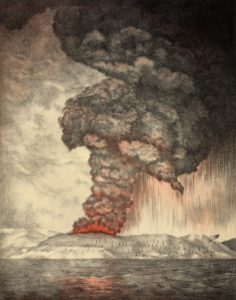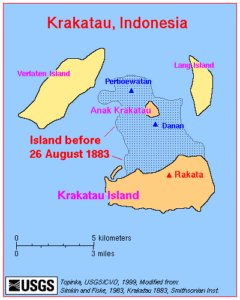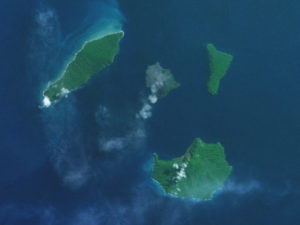Long before Mount St. Helens erupted, the most famous volcanic eruption in modern times occurred in Indonesia—when the volcano on Krakatau Island erupted. It has allowed an ecological “experiment” to be followed for more than a century.
Krakatau is an island between Java and Sumatra, previously dominated by a group of ancient volcanic cones. During the spring of 1883, plumes of ash and smoke at least six miles high appeared above the island, delighting some observers and worrying others.

The worriers were right. About 1 PM on August 26, a major eruption occurred, blasting ash and smoke 15 miles high. Much of the discharged material fell back into the cone, blocking further emissions and causing pressure to build up. The next morning, the earth roared, a sounds that could be heard 2,800 miles away in Australia. Four catastrophic blasts followed in rapid succession, a total force ten times greater than the Mount St. Helens eruption. A super-heated steam cloud spread for 25 miles around the blast. A tsunami launched a 120-foot wall of water that drowned nearby towns. More than 36,000 persons perished.

When the eruption ended, the northern half of the island of Krakatau had been blasted away or sunk into the sea. The island is now only about 5.5 miles long and 3 miles wide, about half its original size. Since the 1930s, however, a small volcanic cone, called Anak Krakatau (Child of Krakatau) has grown from the submerged part of the island. Anak Krakatau has continued to experience small eruptions since then, building the size and height of the cone, and frightening those who live in the region (the last major eruption was in 2007).
The destruction caused by the Krakatau eruption was a human tragedy, but it has also provided a location to study ecological succession like no other. All life was destroyed on Krakatau and two small adjacent islands. Because of the complete extinction and because there are ecologically diverse islands nearby, watching subsequent changes to the island has provided scientists with a rare chance to study ecology on a large scale, without ethical questions about destroying life or ecosystems to understand them.
Of particular interest has been, studying patterns of ecological colonization and succession, testing a theory by ecologists Robert Whittaker and E. O. Wilson known as “island biogeography.” They supposed that barren islands accumulated colonizing species at an initially rapid rate that slowed to an equilibrium as the number of new colonizing species equalled earlier colonists that were becoming locally extinct through competition and habitat change.
The data from Krakatau confirmed their theory in most ways. Many studies of the flora and fauna of the island have been conducted over the past century. Although the lava flows had sterilized the land surface, layers of ash provided habitat for plant colonists. The coastal areas developed first, followed by interior grasslands and then forests. Although the island contains relatively few tree species compared to mature tropical rainforests, forests now cover most of the island. As plants colonized, so did invertebrates and eventually vertebrates, including birds, reptiles and mammals. In each case, a period of rapid colonization has been followed by a gradual leveling off.

Anak Krakatau provides another interesting site. Because it has continued to erupt, the island’s successional path has been chaotic, with reversals and repetitive patterns of arrival and disappearance of species. This confirms the more modern interpretation of ecological succession as a dynamic process, pushed and pulled in different directions by the disturbances that are common, not rare, in nature.
References:
Bagley, Mary. 2017. Krakatao Volcano: Facts About 1883 Eruption. Live Science, September 14, 2017. Available at: https://www.livescience.com/28186-krakatoa.html. Accessed July 5, 2018.
Bush, Mark B. and Robert J. Whittaker. 1991. Krakatau: colonization patterns and hierarchies. Journal of Biogeography (1991) 18:341-356. Available at: http://www.sfu.ca/geog315-new/readings/Bush_Whittaker_91.pdf. Accessed July 5, 2018.
Thornton, I. W. B. et al. 1988. Colonization of the Krakatau Islands by vertebrates : Equilibrium, succession, and possible delayed extinction. Proceeding of the National Academy of Sciences U.S. 85:515-518. Available at: https://www.ncbi.nlm.nih.gov/pmc/articles/PMC279581/pdf/pnas00254-0224.pdf. Accessed July 5, 2018.
